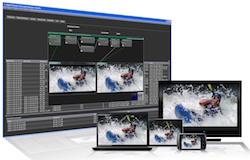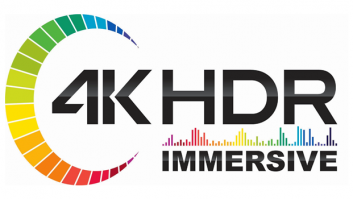
Compression specialist Vanguard Video has developed HEVC/H.265 encoding technology that is being used in Digital Rapids’ new Transcode Manager 2.0 (pictured), media transformation software and Kayak workflow platform.
Transcode Manager 2.0 software is claimed to provide “outstanding efficiency, scalability, quality and workflow agility for applications from post production and archive to multiscreen distribution.” Vanguard’s V.265 HEVC encoding technology, which can be used for Ultra HD, will be available for Digital Rapids systems as a modular component integrating directly into the Kayak platform.
Besides offering 4K/UltraHD support, V.265 can do realtime live 1080p software encoding and realtime mobile streaming.
It has a multi-threaded architecture and incorporates patented motion estimation algorithms. It supports both Windows and Linux (32- and 64-bit), and is provided as an SDK so that OEMs (such as Digital Rapids) and content providers can easily integrate it into their products and workflows.
“Video distribution and broadcast companies around the world are searching for higher quality video solutions, especially with the huge increase in mobile video. The new international standard, H.265, provides a dramatic increase in bitrate efficiency delivering high-quality video at half the bandwidth,” said Irena Terterov, CEO and Founder of Vanguard Video, who predicted that “H.265 will be the dominant video compression standard for the next 10 years.”
One of the new features of Transcode Manager 2.0 that will help enable 4K use is its optimization for 64-bit processors and operating systems. This extends its highly efficient multi-threaded architecture and optimises memory usage, something that will be particularly beneficial for processing ultra-high resolution frame sizes. Modular workflow components designed for 64-bit operation can also interoperate seamlessly with 32-bit components within a single Transcode Manager workflow, maximizing flexibility while taking full advantage of available performance optimizations.
Other new additions to Transcode Manager 2.0’s format support include: Dolby E audio decoding; input support for media in the GXF and LXF container formats; GXF output support; and SDI ancillary data creation for inclusion as data tracks within interchange formats.
Version 2.0 also boasts: adaptive, automated decision-making with rich metadata support; intuitive, visual workflow design tools; dynamic deployment; fast, easy integration of new and emerging technologies; and a deep ecosystem of third-party technology partners.
These new capabilities “are perfect examples of how Kayak provides a future-proof platform for both evolutionary and disruptive market changes,” said Digital Rapids’ Product Manager, Darren Gallipeau. “Kayak’s catalogue-based architecture and flexible deployment model also enable us to bring such capabilities to our customers on a feature-by-feature basis without the lengthy release cycles of typical ‘monolithic’ software upgrades.”
Xilinx FPGA acceleration
At NAB, Vanguard showed a hardware implementation of its HEVC technology running on a Xilinx KintexTM-7 FPGA. The FPGA accelerates portions of the H.265 encoder and the hardware integrates with Vanguard Video’s software implementation of the H.265 standard. This combination should allow OEMs to create powerful, cost-effective realtime HEVC systems.
“It is very difficult to encode H.265 in real time because it is extremely resource intensive. A realtime software implementation today requires Intel Xeon or similar high-end x86 processors,” said Terterov. “By offloading processing of various H.265 components onto a Xilinx FPGA we are able to achieve higher performance with lower cost x86 CPUs.”
“Realtime video processing is a key requirement in broadcast applications and as the world moves to 4K2K video and the ability for any device with a screen to receive streaming video, particularly smart phones and tablets, advanced H.265 technology is critical to the broadcasters success,” added Ben Runyan, Director of Broadcast and Consumer Segment Marketing at Xilinx.
Stream 3.8 gets 4K support
Digital Rapids has released upgraded v3.8 software for its ingest, encoding and streaming systems that includes support for 4K Ultra HD H.264 encoding.
Updates include encoding quality and performance enhancements, expanded ad insertion support and new Netflix production presets.
The software, for its StreamZ, StreamZHD and Flux systems, also includes: enhancements to MPEG-2 and DVCPro encoding; expanded support for automated multiscreen advertising insertion workflows; and new predefined project files for transforming content for Netflix delivery.
Besides 4K support, H.264 (AVC) encoding enhancements in Stream 3.8 include increased quality, significant performance gains (up to 25% faster depending on host system and content characteristics).
Stream 3.8 extends the software’s support for automated, live advertising and monetisation workflows with new support for the latest updated SCTE-104 specification and the HTTP Live Streaming (HLS) protocol. Cueing messages in live input sources are detected to automate the insertion of markers into HLS outputs for triggering subsequent ad insertion or replacement.
The new project files for Netflix asset preparation enable the streaming service’s content suppliers to easily and consistently create high-quality deliverables meeting Netflix specifications.
Other new features in version 3.8 include: enhanced MXF compatibility, including support for uncompressed YUV video; improved MOV file format handling; expanded support for up to 64 audio tracks in Transport Streams; live 5.1-to-stereo and stereo-to-mono audio down-mixing; and enhancements to the optional HLS (e.g. iPhone and iPad) encoding and segmenting module.
“The encoding performance and quality gains in the new version will bring immediate benefits for most media transformation applications, and with a broad range of specific yet powerful new features and enhancements, users from post production facilities and studios to multiscreen content distributors will each find operational improvements for their particular needs,” claimed Gallipeau.
By David Fox






